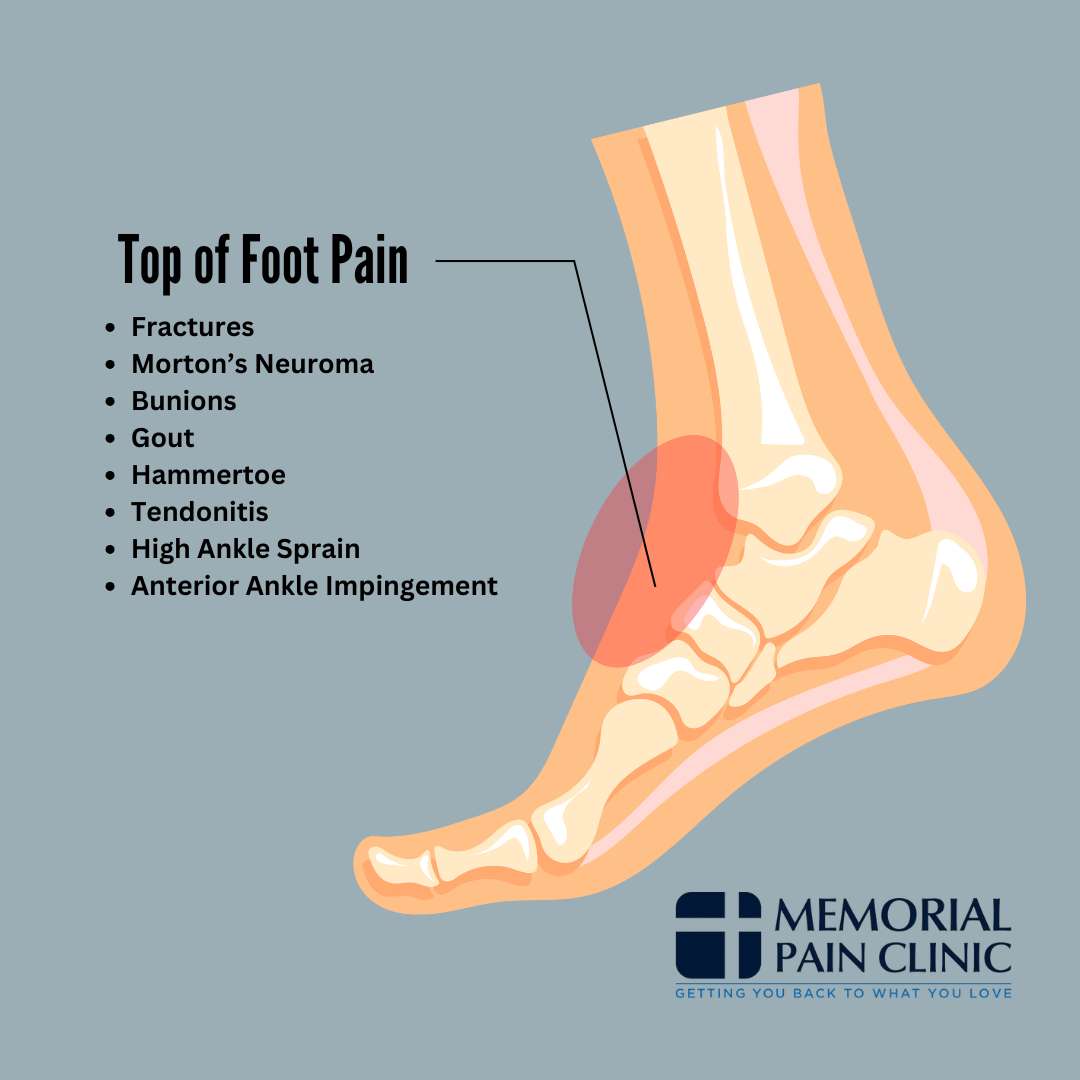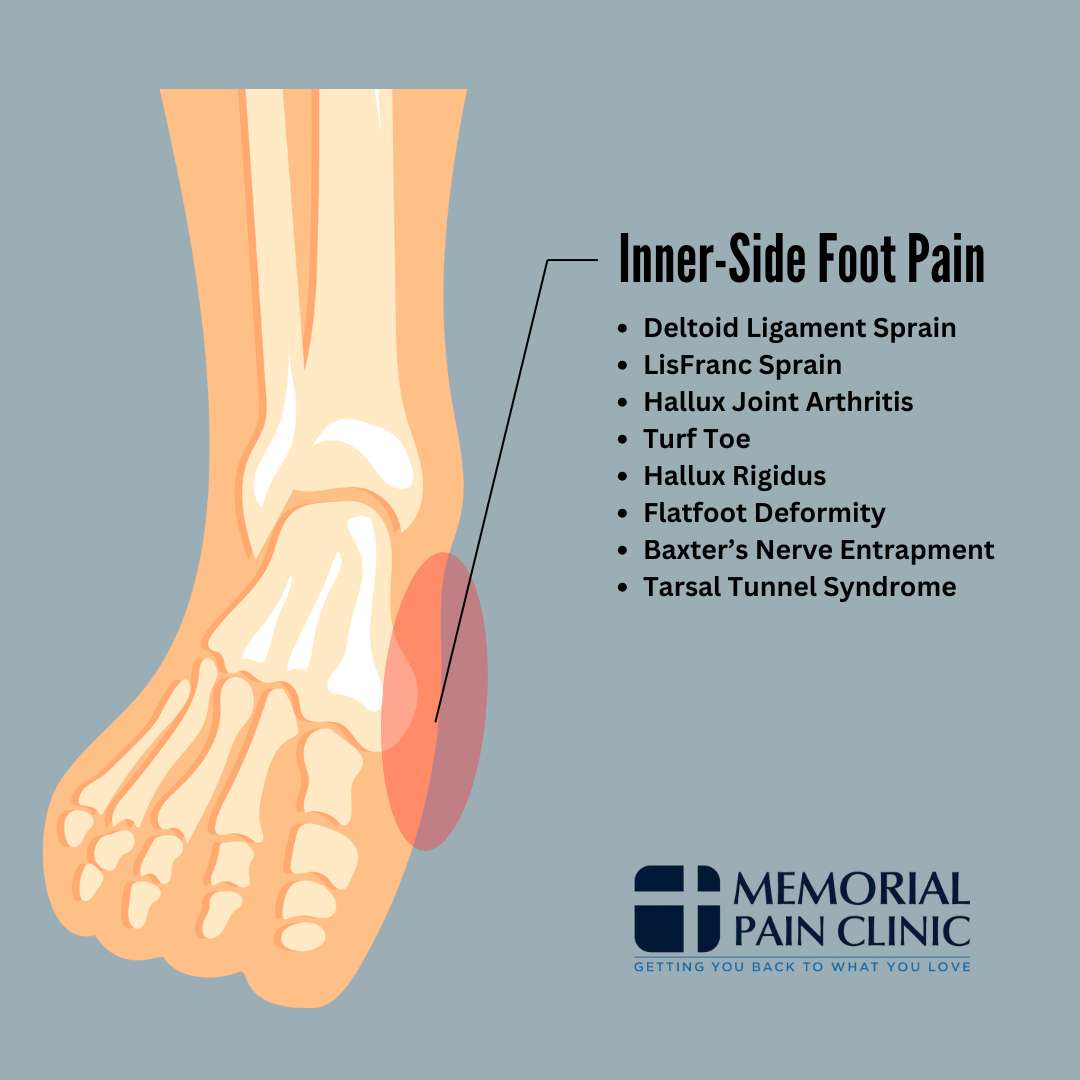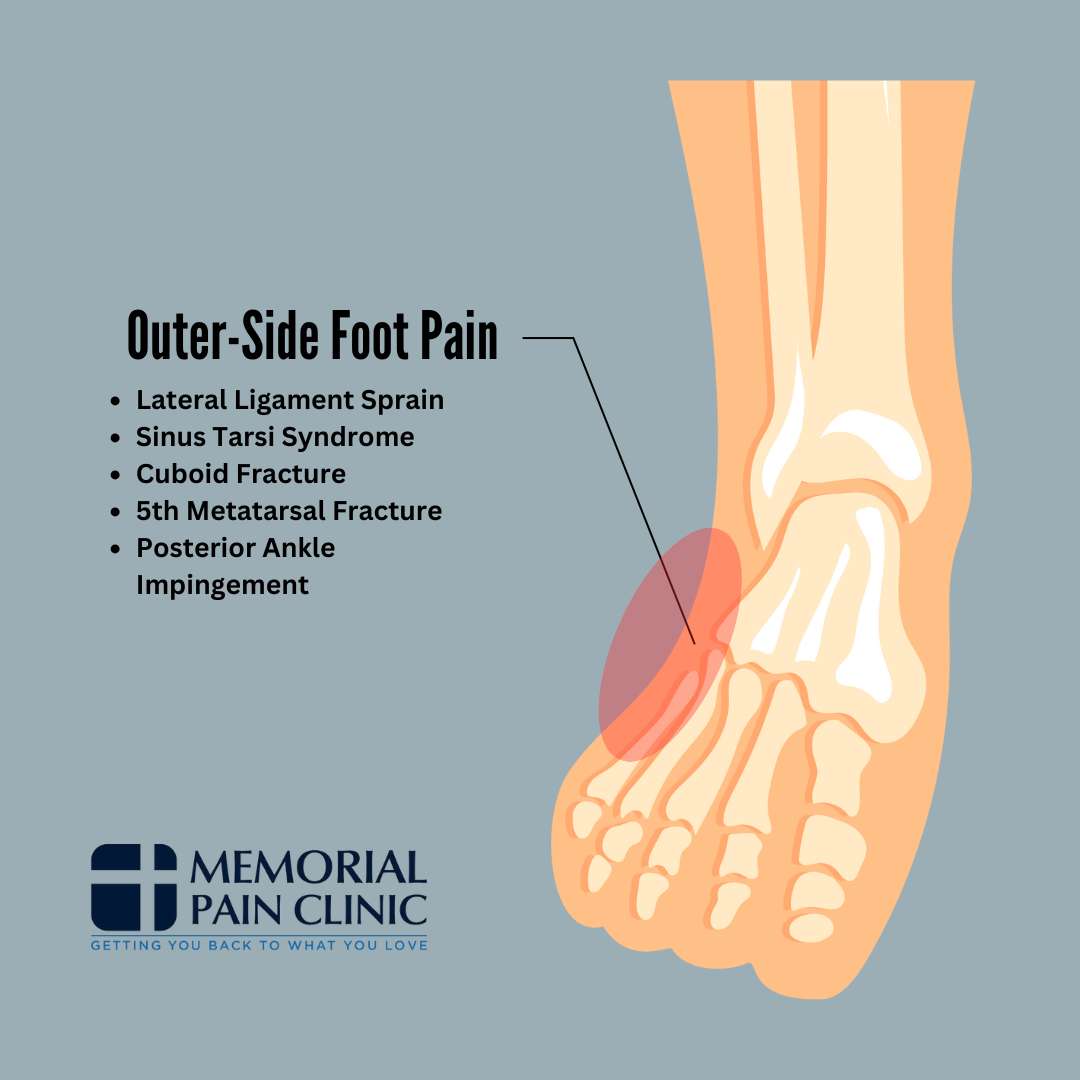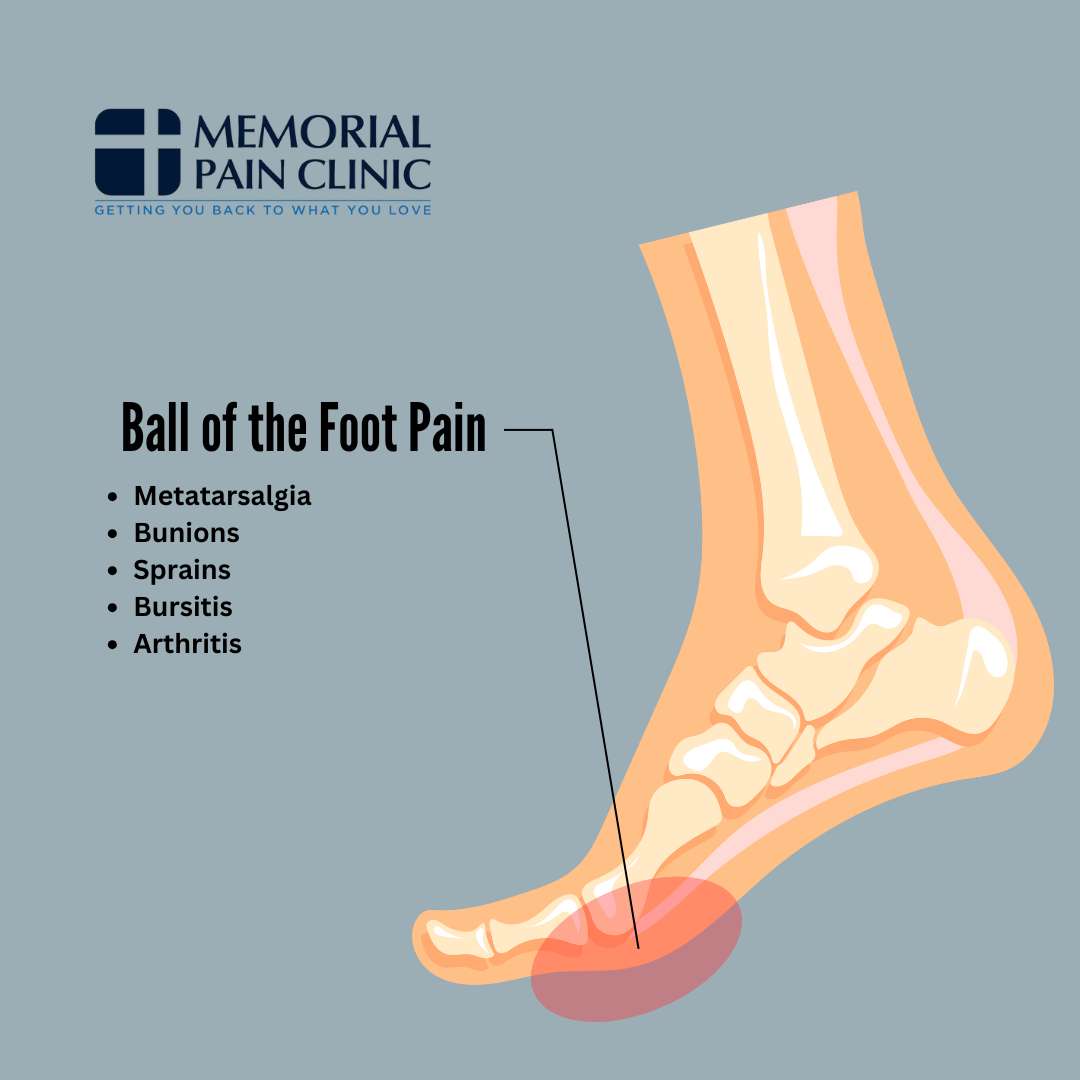A foot pain chart is a helpful guide for anyone experiencing foot and ankle pain. Understanding the sources of discomfort can be challenging, whether it’s lingering pain in the heel or intense pain radiating through the metatarsal bones and toes.
Commonly linked to overuse, injury, or conditions like plantar fasciitis, foot pain can interfere with your daily routine and limit mobility. Even simple actions, like walking or standing, can become difficult when dealing with pain in areas like the big toe joint, ankle, or heel bone.
At Memorial Pain Clinic in Tulsa, we aim to help you find relief and get back to an active life. If you’re experiencing foot pain that’s impacting your daily activities, check out the foot pain chart below and reach out to a Tulsa pain management specialist today.
Call (918) 200-9944 or contact us online to schedule an appointment and start on the path to pain relief!
Foot Anatomy
The foot’s structure consists of several important parts that work together to keep you balanced and moving comfortably.
It includes bones like the metatarsal bones, tarsal bones, and the heel bone, which all support the body’s weight. The big toe joint, third and fourth toes, and fifth metatarsal bone help with balance and movement. The Achilles tendon connects the calf muscles to the heel, giving power to each step, while the plantar fascia, a thick band of tissue along the foot’s bottom, helps absorb shock and supports the arch.
When any of these parts become strained or injured, it can cause foot pain that affects your everyday activities.
Foot Pain Chart Based on Location

Foot pain charts help pinpoint specific areas of foot and ankle pain and highlight the potential causes of discomfort in each area. A foot pain chart can make it easier to identify your pain and help you decide if it’s time to consult a Tulsa foot pain physician for an accurate diagnosis and effective treatment plan.
Top of Foot Pain

Top-of-foot pain can make even the simplest movements uncomfortable. It often stems from issues within the bones, joints, or soft tissues on the foot’s upper surface.
Here, we’ll break down some of the common foot pain causes, helping you understand where your pain might be coming from and what steps to take toward relief.
Talus Fractures, Stress Fractures, and Metatarsal Fractures
Fractures are a common source of pain at the top of your foot. Injuries like talus fractures, navicular stress fractures, and metatarsal fractures can occur due to sudden impact, repetitive strain, or overuse.
A stress fracture might develop gradually from activities that place continuous stress on your foot, while a metatarsal fracture typically results from a direct impact, like dropping something heavy on your foot.
An ankle fracture can be caused by an injury to the talus bone inside the ankle joint, which connects your foot and leg. Similarly, a fracture of the navicular bone—a small bone on the top of the midfoot—can lead to significant foot pain and difficulty walking. A navicular stress fracture is common in athletes and can cause intense pain that worsens with activity.
Bone fractures cause severe pain and may make walking or standing nearly impossible. Getting an accurate diagnosis from a foot and ankle specialist is important to promote proper healing and prevent complications down the road.
Morton’s Neuroma
If you’re experiencing a burning pain or tingling sensation between the third and fourth toes, Morton’s Neuroma could be the cause.
This condition is a type of neuropathy that results from thickened nerve tissue and is often triggered by narrow toe boxes or footwear that pinches the toes together. Left untreated, the pain can spread, leading to lingering pain on the top of the foot.
Wearing proper-fitting shoes and getting the right neuropathy treatment in Tulsa can help alleviate pain and allow you to regain normal foot function.
Bunions
Bunions, or bumps at the base of the big toe joint, can lead to toe pain and discomfort on the top of the foot. Bunions often develop due to foot shape and pressure from ill-fitting shoes. The pain can worsen over time, particularly with activities that involve a lot of walking or standing.
Gout
Gout, a form of arthritis, can cause sudden, intense pain on the top of the foot, particularly around the big toe joint. This condition occurs when uric acid crystals build up in the joints, leading to pain and inflammation. Gout flares can be unpredictable, with pain that often comes on suddenly and severely.
Hammertoe
A hammertoe deformity can cause persistent pain and discomfort on the top of the foot, particularly in the smaller toes. This develops when the toe joints become misaligned, often due to tight footwear or your foot shape.
Hammertoe may cause the toes to press against the top of the shoe, leading to intense pain during everyday activities. With the proper treatments, foot pain caused by hammertoe can go away.
Tendonitis
Tendonitis on the top of the foot can develop from repetitive activities or excessive strain, often impacting the tibialis anterior tendon along the front of the ankle and foot. This type of pain is usually associated with overuse or sudden increases in activity.
Tibialis anterior tendonitis causes intense pain that can make walking or moving the foot difficult. Rest, physical therapy, and targeted treatments can help alleviate foot pain from tendonitis.
High Ankle Sprain
A high ankle sprain affects the ligaments above the ankle joint and can cause pain that extends to the top of the foot. This type of sprain usually occurs from twisting or rolling the ankle, leading to severe pain and swelling.
Unlike lower ankle sprains, a high ankle sprain may take longer to heal and requires specific treatments to support the ligaments and relieve foot pain. If the sprain is not treated properly, you could develop ankle instability, putting you at a higher risk of future ankle sprains.
Anterior Ankle Impingement
If you feel discomfort or lingering pain on the front or top of your ankle, anterior ankle impingement might be the cause.
This condition occurs when the soft tissues at the front of the ankle become pinched, usually due to repeated bending of the foot. It’s common in athletes and can cause pain with movements like squatting or walking uphill.
To relieve pain caused by anterior ankle impingement, it’s important to get proper sports injury treatment in Tulsa.
Why Does the Top of My Foot Hurt All of a Sudden?
If you’re asking, “Why does the top of my foot hurt all of a sudden?,” it’s likely due to an underlying issue like a foot sprain, stress fracture, or tendonitis. Sometimes, normal wear and tear of the ankle joint can lead to ankle arthritis, causing sudden pain on the top of the foot.
Using a foot pain chart to identify the source of this pain can help you find relief and prevent further injury.
Inner Side of Foot Pain

Inner-side foot pain can impact your ability to walk, run, or even stand comfortably. It often stems from issues with the ligaments, joints, or nerve tissue on this part of the foot. Understanding the potential causes can help you identify the source of your discomfort and take steps toward relieving it.
Deltoid Ligament Sprain
The deltoid ligament supports the ankle joint on the inner side of your foot. A deltoid ligament sprain can result from twisting or over-stressing the ankle, causing severe pain and swelling along the inner side of your foot and ankle. This type of injury often leads to difficulty bearing weight on the foot.
LisFranc Sprain
A LisFranc sprain occurs in the midfoot area where the metatarsal bones meet the tarsal bones. A sprain can happen when the foot twists unexpectedly or is overstressed, causing intense pain on the inner side of the foot. This type of LisFranc injury can affect the bones and ligaments, making it essential to get an accurate diagnosis and targeted treatment to prevent lasting pain.
Hallux Joint Arthritis
Hallux joint arthritis affects the big toe joint and can cause lingering pain and stiffness on the inner side of the foot. This condition, often linked to wear and tear or rheumatoid arthritis, can make movements like walking or bending the toe painful. Arthritis treatment in Tulsa can help relieve tension and improve mobility in the big toe.
Turf Toe
Turf toe is a common injury in athletes. It occurs when the big toe is forcibly bent upward, causing sudden and severe pain at the inner base of the toe. This injury impacts the soft tissues and ligaments in the big toe joint, leading to pain, swelling, and limited movement.
Hallux Rigidus
Hallux rigidus is a form of arthritis that limits movement in the big toe joint, causing persistent pain on the inner side of the foot. This condition can make it difficult to walk or stand comfortably, especially in shoes with narrow toe boxes.
Flatfoot Deformity
A flatfoot deformity or flat feet can cause pain along the inner side of the foot due to a collapsed arch. This condition strains the soft tissues and ligaments, leading to lingering pain and fatigue, especially after prolonged standing or walking.
Baxter’s Nerve Entrapment
Baxter’s nerve entrapment occurs when the nerve in the inner heel becomes compressed, causing pain or numbness along the inner side of the foot. This often results from overuse or pressure on the heel bone.
Rest, physical therapy, and nerve injury treatment in Tulsa can help relieve pressure on the nerve and reduce inner foot and heel pain.
Tarsal Tunnel Syndrome
Tarsal tunnel syndrome occurs when the tibial nerve is compressed as it passes through the tarsal bones along the inner side of the ankle. This compression can cause intense pain, tingling, and burning sensations radiating from the ankle to the inner side of the foot.
Outer Side of Foot Pain

Outer-side foot pain can be particularly uncomfortable, often limiting your movement and daily activities. Pain in this area may be due to injuries affecting the ligaments, bones, or soft tissues along the foot’s outer edge. Understanding the causes of outer foot pain can help you find relief and get back to your normal routine.
Lateral Ligament Sprain
A lateral ligament sprain occurs when the ligaments on the outer side of the foot become overstretched, often from a twist or sudden movement. This injury is common in activities that involve quick changes in direction and can lead to severe pain and swelling along the outer side of the foot and ankle joint.
Sinus Tarsi Syndrome
Sinus tarsi syndrome is a disorder that causes pain and swelling in the area between the heel bone and the ankle joint, leading to instability on the foot’s outer side. This condition can make movements like walking on uneven ground especially painful.
Cuboid Fracture
A cuboid stress fracture involves a break in the cuboid bone located on the outer side of the foot. This injury can result from direct impact, excessive pressure, or repetitive stress. Pain from a cuboid fracture is usually sharp and intense. This pain can make it challenging to bear weight on the foot.
5th Metatarsal Fracture
The 5th metatarsal bone connects your little toe to the rest of your foot and is prone to fractures, especially during sports or high-impact activities. A 5th metatarsal fracture is often known as a Jones fracture. This injury can cause intense foot pain and swelling, making it difficult for you to walk or wear shoes comfortably.
Posterior Ankle Impingement
Posterior ankle impingement occurs when the soft tissues at the back of your ankle become compressed, causing pain that can radiate to the outer side of your foot.
This condition is common among athletes who perform repetitive ankle movements, such as dancers or soccer players. It is sometimes confused with Achilles tendonitis because both conditions cause pain in the back of the ankle, but they are different. Achilles tendonitis involves inflammation of the Achilles tendon, which connects the calf muscles to the heel bone.
Symptoms of posterior ankle impingement often include lingering pain and stiffness, which can be managed with rest and treatments to relieve pressure in the ankle.
Pain in Bottom of Foot

Experiencing pain in the bottom of your foot can make every step uncomfortable. This type of foot pain often stems from heel, arch, or toe issues. Here, we’ll discuss the most common reasons for pain along the bottom of the foot.
Heel Spurs
Heel spurs are bony growths that develop on the heel bone, often leading to intense pain at the bottom of the foot, especially with each step. Heel spurs are commonly associated with plantar fasciitis, as the body forms this bony growth in response to strain on the plantar fascia. Pain from a heel spur can feel sharp or like a bruise, making walking challenging.
Plantar Fasciitis
Plantar fasciitis is a common cause of heel pain and pain in the bottom of the foot, occurring when the plantar fascia—a thick band of tissue supporting the arch—becomes inflamed or overstretched.
A specific type, known as mid-portion plantar fasciitis, affects the middle part of this band, often causing severe pain that centers in the heel and arch area, especially with the first steps in the morning or after long periods of rest.
Fat Pad Atrophy
Fat pad atrophy happens when the natural fat pad under the heel wears down over time, reducing the cushioning that protects the heel bone. Without this padding, the heel becomes more vulnerable to impact, causing pain at the bottom of the foot. People with fat pad atrophy often feel discomfort with each step.
Capsulitis
Capsulitis is the inflammation of the soft tissues around the joints in the foot, causing pain in the ball of the foot or the base of the second toe. This condition is commonly caused by repetitive stress or abnormal foot shape.
Bursitis
Bursitis is the inflammation of the bursae, which are small fluid-filled sacs that cushion the joints and prevent friction. When bursae in the foot become irritated, it can lead to burning pain at the bottom of the foot, especially in the heel or ball of the foot.
Peroneal Longus Tendonitis
Peroneal tendonitis affects the tendon that runs along the foot and attaches to the big toe joint. Overuse or strain on this tendon can cause pain to radiate from the outer edge to the bottom of the foot, leading to pain and discomfort with activity.
Ball of the Foot Pain

Pain in the ball of the foot can make walking, standing, or running extremely uncomfortable. This area, where the metatarsal bones meet the toes, often endures a lot of stress and impact. This section will explain the most common causes of pain in this area.
Metatarsalgia
Metatarsalgia is a condition that causes intense pain in the ball of the foot, usually due to stress on the metatarsal bones. This pain feels sharp or burning and is typically aggravated by running or standing for long periods.
Bunions
Bunions are bony bumps that develop at the base of the big toe joint, shifting pressure onto the ball of the foot and causing pain. Sometimes, a tailor’s bunion forms near the little toe, creating similar discomfort. Bunions can result from genetics, foot shape, or wearing tight shoes.
Sprains
Sprains in the ball of the foot can result from sudden twists, overstretching, or injury to the ligaments. This can lead to severe pain, swelling, and limited mobility in the affected area.
Bursitis
Bursitis occurs when the bursae, small fluid-filled sacs that reduce friction around the joints, become inflamed. Bursitis can lead to burning pain or tenderness in the ball of the foot, especially with pressure.
Arthritis
Midfoot arthritis can lead to stiffness, pain, and swelling, making it harder to move comfortably. This condition affects the joints and soft tissues in the ball of the foot and is more common among older adults or those with a history of foot and ankle pain.
Treatment Options for Severe Pain in the Foot
Exploring effective treatment options is essential for relief from severe foot pain. Treatment may include physical therapy to improve mobility, custom orthotics to support the foot’s natural structure, and anti-inflammatory medications to reduce swelling.
For persistent issues, chronic pain management in Tulsa may be the best option. Our clinic offers advanced solutions, including specialized therapies tailored to relieve foot pain and enhance your quality of life.
Contact a Foot and Ankle Pain Doctor at Memorial Pain Clinic in Tulsa, OK
If you’re struggling with foot pain that affects your daily life, don’t wait to find relief. At Memorial Pain Clinic in Tulsa, OK, we’re dedicated to helping you manage pain through personalized treatment options. Whether you’re dealing with severe foot pain from an injury or chronic pain conditions, our team is here to support your journey to recovery.
Call us today at (918) 200-9944 to schedule an appointment and take the first step toward lasting relief.

